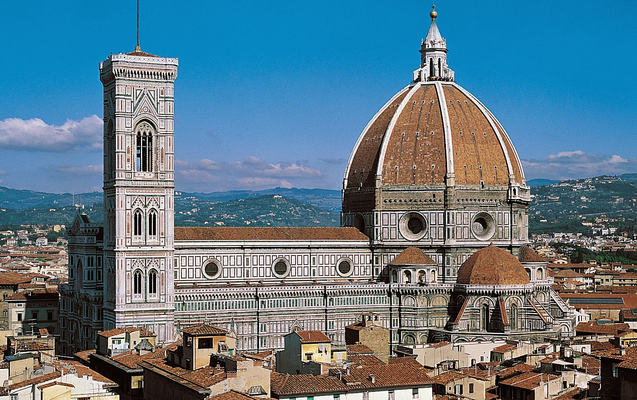 The 5 greatest architectural works
The 5 greatest architectural works
I assumed @zuerich was German-Swiss and very rich!
He posted many photos of Europe's beautiful and magnificent nature and architecture.
As an East Asian man, I really enjoyed his photos.
He seemed to be able to speak English, German and Spanish.
He wrote articles in English and German.

@zuerich made an honorable request to me!😄
Although his request was very honorable, it troubled me!😂
Perhaps he asked me to introduce him to the greatest buildings in my world!
Since I am not familiar with English, I was not sure if I understood his request!
Considering the generosity, kindness, and support @zuerich has shown me over the years, it was hard to refuse his honorable request!
So, I decided to gather my courage and try writing some awkward English sentences!😀
I hope you understand that I have the English conversation skills of an American elementary school student!😄
 Sansa, Buddhist Mountain Monasteries in Korea
Sansa, Buddhist Mountain Monasteries in Korea
Buseoksa Temple (Hangul: 부석사, Hanja: 浮石寺) is a Buddhist temple located near Mt. Bonghwang in Buseok-myeon, Yeongju City, Gyeongsangbuk-do, founded by the prominent scholar-monk Uisang in 676, the 16th year of Munmu of Silla. Buseoksa temple is also well known as the "Temple of the Floating Stone".
Korean Huayan school was highly celebrated here by the lectures of Uisang, who was later called the respected scholar of Buseok and later the school also gained the name Buseok school.[1] The temple houses the Muryangsujeon, which is the second oldest standing wooden building in South Korea, re-constructed in 1376.
In 1372, large numbers of annexes were re-established by the great monk Won-eung at the time under King Gongmin's reign in 1376.[2] A few buildings during Goryeo era (9th century to the late 14th century) remain until now, one of which is the main hall called Muryangsujeon located at the highest level, where Amitabha is enshrined.
Buseoksa Temple (Hangul: Buseoksa Temple, Hanja: 浮石寺) is the most famous building built 1,500 years ago.
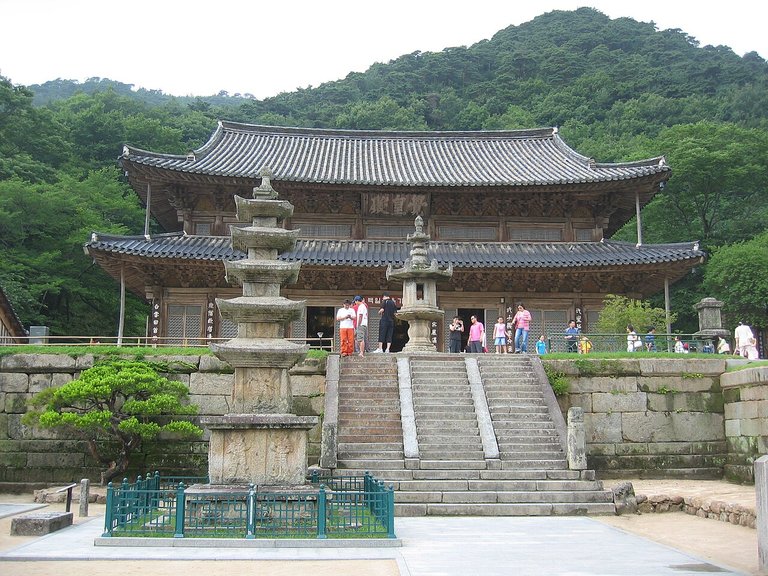 Hwaeomsa (Sino-Korean: hwa-eom-sa 華嚴寺, literally "Flower Garland Temple")
Hwaeomsa (Sino-Korean: hwa-eom-sa 華嚴寺, literally "Flower Garland Temple")
Hwaeomsa (Sino-Korean: hwa-eom-sa 華嚴寺, literally "Flower Garland Temple") is a head temple of the Jogye Order of Korean Buddhism. It is located on the slopes of Jirisan, in Masan-myeon, Gurye County, in South Jeolla Province, South Korea.
Hwaeomsa (Sino-Korean: hwa-eom-sa 華嚴寺, literally "Flower Garland Temple") is one of the oldest wooden buildings, built over 1,000 years ago.
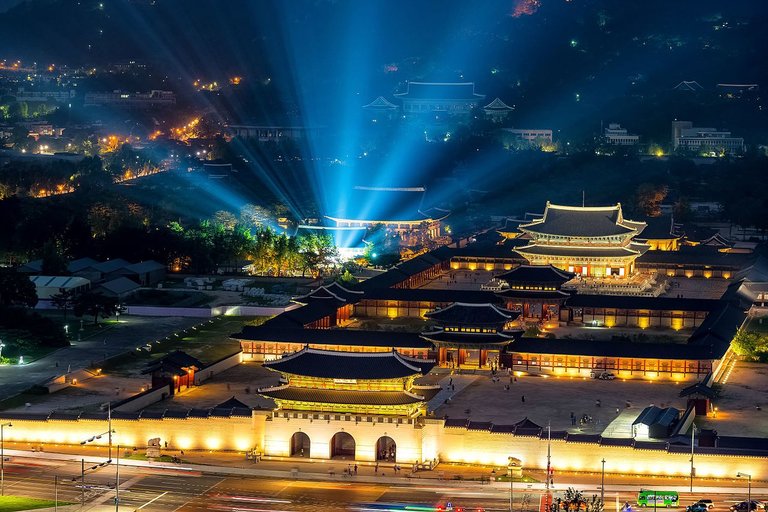 Gyeongbokgung at night
Gyeongbokgung at night
Gyeongbokgung (Korean: 경복궁; Hanja: 景福宮), also known as Gyeongbokgung Palace or Gyeongbok Palace, was the main royal palace of the Joseon dynasty. Built in 1395, it is located in northern Seoul, South Korea. The largest of the Five Grand Palaces built by the Joseon dynasty, Gyeongbokgung served as the home of the royal family and the seat of government.
Gyeongbokgung continued to serve as the main palace of the Joseon dynasty until the premises were destroyed by fire during the Imjin War (1592–1598) and abandoned for two centuries. However, in the 19th century, all of the palace's 7,700 rooms were restored under the leadership of Prince Regent Heungseon during the reign of King Gojong. Some 500 buildings were restored on a site of over 40 hectares.[1][2] The architectural principles of ancient Korea were incorporated into the tradition and appearance of the Joseon royal court.
In the early 20th century, much of the palace was systematically destroyed by Imperial Japan during its occupation of Korea.[3] On January 21, 1963, it was designated as a cultural property.[4] Since the 1990s, the walled palace complex is gradually being restored to its original form. It also houses the National Palace Museum and the National Folk Museum within the premises of the complex.
Gyeongbokgung (Korean: Gyeongbokgung Palace; Hanja: 景福宮) is one of the palaces where kings lived.
Japan destroyed this palace and it is currently being restored.
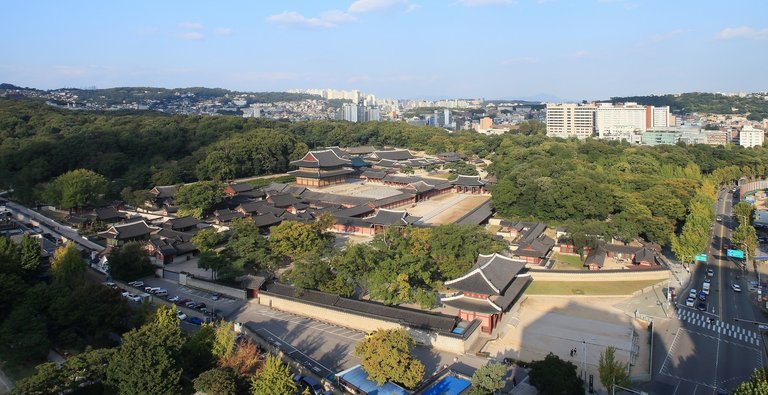 Changdeokgung (Korean: 창덕궁; lit. The Palace of Prospering Virtue)
Changdeokgung (Korean: 창덕궁; lit. The Palace of Prospering Virtue)
Changdeokgung (Korean: 창덕궁; lit. The Palace of Prospering Virtue), also known as Changdeokgung Palace or Changdeok Palace, is set within a large park in Jongno District, Seoul, South Korea. It is one of the "Five Grand Palaces" built by the kings of the Joseon dynasty (1392–1897).[1] As it is located east of Gyeongbok Palace, Changdeokgung—along with Changgyeonggung—is also referred to as the "East Palace" (동궐; 東闕; Donggwol).
Changdeokgung was the most favored palace of many Joseon kings and retained many elements dating from the Three Kingdoms of Korea period that were not incorporated in the more contemporary Gyeongbokgung. One such element is the fact that the buildings of Changdeokgung blend with the natural topography of the site instead of imposing themselves upon it. Like the other Five Grand Palaces in Seoul, it was heavily damaged during the Japanese occupation of Korea. (1910–1945). Currently, only about 30% of the pre-Japanese structures of the East Palace Complex (Changdeokgung together with Changgyeonggung) survive.[2]
Changdeokgung was built after Gyeongbokgung Palace.
Changdeokgung is larger than Gyeongbokgung Palace and has a more beautiful garden.
Changdeokgung Palace was also destroyed by Japan and is currently being restored.
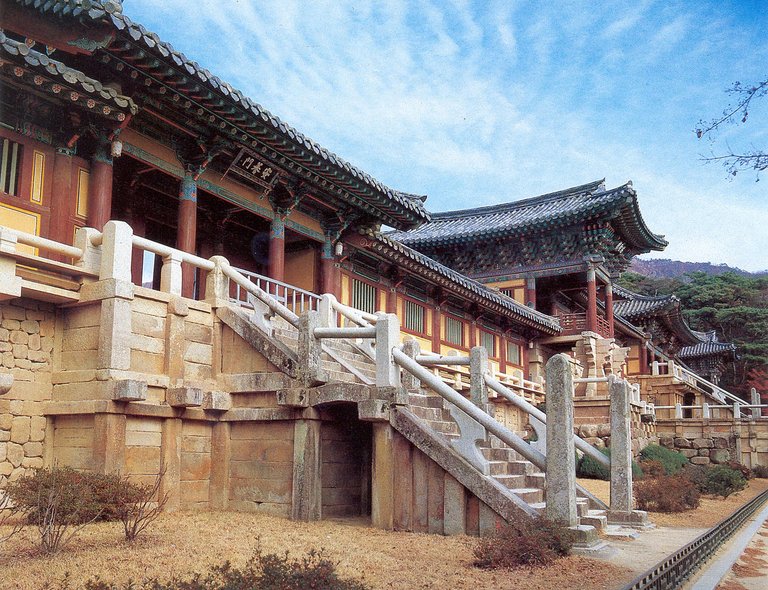 Bulguksa (Korean: 불국사)
Bulguksa (Korean: 불국사)
Bulguksa (Korean: 불국사) is a Buddhist temple on Tohamsan, in Jinheon-dong, Gyeongju, North Gyeongsang Province, South Korea.
It is a head temple of the Jogye Order of Korean Buddhism and contains six National Treasures, including the Dabotap and Seokgatap stone pagodas, Cheongun-gyo (Blue Cloud Bridge), and two gilt-bronze statues of Buddha. The temple is classified as Historic and Scenic Site No. 1 by the South Korean government.[1] In 1995, Bulguksa and the nearby Seokguram Grotto were added to the UNESCO World Heritage List.
The temple is considered as a masterpiece of the golden age of Buddhist art in the Silla kingdom. It is currently the head temple of the 11th district of the Jogye Order of Korean Buddhism.
Among the earliest woodblock prints in the world, a version of the Dharani sutra dated between 704 and 751 was found there in 1966.[2][3][4][5][6] Its Buddhist text was printed on a 8 cm × 630 cm (3.1 in × 248.0 in) mulberry paper scroll.
Bulguksa Temple was also restored because it was destroyed by Japan.
The Seokguram Grotto
inside Bulguksa Temple is also famous.
I described some of the oldest and most famous structures and buildings in the world where I live.
There are many more great buildings, but I have posted the five I chose.
I hope you like my post! 😃
Lol. Even though you did not understand @zuerich, you still did an awesome job with the shots you provided. They are indeed very beautiful 😍❤️
Dear my lady @iskawrites !
Still, I definitely wanted to write a reply.It's true that I didn't understand @zuerich's request.
By the way, I wonder if there are any classical buildings that represent Nigeria!😃
You did good. You have my support.
Yes, we have lots of them. 😄
Thank you for your support! 😃
I wonder what is your support!
I wonder it!😄
thanks for your post and this great architecture! I've only visited Hongkong and Hainan. So there is still a lot to discover in East Asia.Dear @goldgrifin007,
I really like Sansa, Buddhist Mountain Monasteries in Korea.
Have a great weekend!
Dear @zuerich !
Thank you for praising my awkward English articles!
I hope your happy and healty!😃
It is difficult for a Western barbarian to grasp the temporal scale of E. Asian history that rests on a foundation of continuous occupation going back tens of thousands of years. My interest in human evolution has not yet delved into the specific peoples and their genetic legacy inherited by the current populations of the Korean peninsula, but I do have a continuing interest in that matter and expect to learn more specifics in due time.
Your selection of structures that convey the unique architectural heritage of E. Asia specific to Korea well illustrates that heritage, and commends to we availed of your post further study and gain of improved appreciation for that style and it's development across the deep history of your culture and people.
Thanks!
Dear @valued-customer !
I want the world I live in to be a Christian society like America!
Although I study history and academically the polytheistic religions of my ancestors, I believe that Jesus is the only savior!
Thank you for praise!😃
Congratulations @goldgrifin007! You received a personal badge!
You can view your badges on your board and compare yourself to others in the Ranking
Check out our last posts:
Dear @hivebuzz !
Thank you!